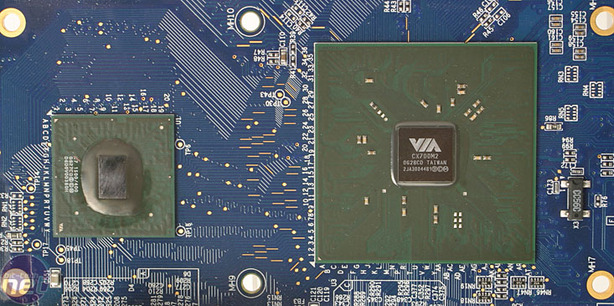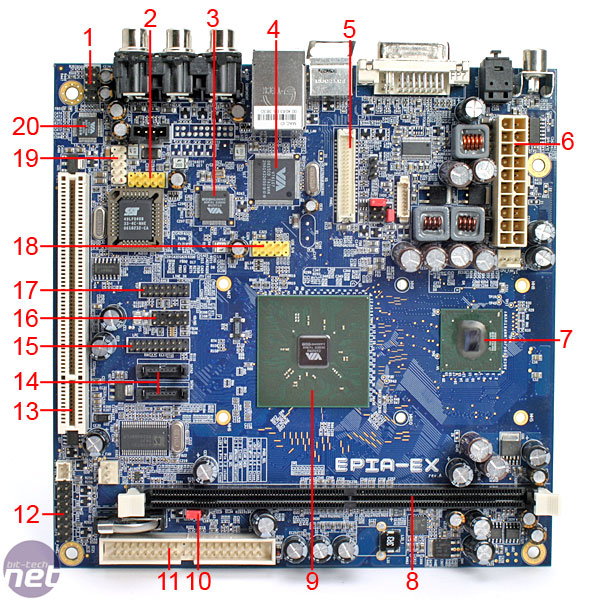VIA EPIA EX 15000G
VIA has dubbed the C7 the world’s first "carbon-free" processor. It's ultra low power, topping out at a maximum of just 12W at 1.5GHz, or 20W at 2GHz and is fabbed on a 90nm IBM SOI (silicon on insulator) process. The chip comes in three variants: C7, C7-D (desktop) and C7-M (mobile). The C7-D ("Esther") is the chip incorporated into the mini-ITX board we're looking at here, and is just 21x21mm square and based on a nanoBGA2 design.The VIA C7 now uses a V4 bus which directly relates to the "quad pumped" 400MHz front side bus that the original Pentium 4 used. How much longer VIA will be able to use it, due to a licensing dispute with Intel, is anyone's guess, but you can still buy the EPIA EX for the foreseeable future.
Just like other CPUs the C7 also includes the NX-bit virus protection, 64KB L1 instruction cache and 64KB L1 data cache as well as 128KB of full speed L2 cache on die. This isn't a huge amount compared to the megabytes in other modern CPUs, but it does keep the power consumption down because you're not having to power a ton of cache transistors.
On the other hand though, powering transistors is more efficient than having a more frequent access of main memory. It has a 16 stage pipeline, two more than the efficient Pentium M, and contains SSE, SSE2 and SSE3 and a full speed FPU (floating point unit calculation engine).

In addition the CPU includes an updated hardware encryption engine with full AES encryption algorithms, RSA hardware assistance and the "world's best random number generator (RNG)" if that's the kind of thing you're after.
To complement this, VIA has included the CX700M2 media processor; an all-in-one northbridge/southbridge/IGP solution that incorporates a 333/400MHz DDR and 400/533MHz DDR2 memory controller, UniChrome Pro II graphics engine and MPEG-2, MPEG-4 and WMV9 playback acceleration with Adaptive De-Interlacing and Video Deblocking technology. To top all of this, its maximum power envelope is just 3.5W!
A modest 200MHz 2D/3D engine is built on the antique AGP 8x architecture and is only DirectX 7 compliant, so certainly isn't made for games. What is special about it however is that it has dual monitor support with integrated (HD)TV out, video input and a separate DVI/LVDS connection. LVDS or Low Voltage Differential Signalling is often used in laptop display transmitters, so further highlighting the whole low profile, low power ethos VIA has behind its products.
Board Layout
The mini-ITX board is just 17cm square with the CPU and IGP "media processor" soldered to the PCB. It's all under one expansive but low profile aluminium heatsink designed to keep it all cool without being noisy. The blue six layer PCB looks quite good, however there is no colour coordination across it.A small 40x40mm fan is the only thing that cools it, and despite being so little it's actually very quiet. In comparison, the 1GHz version is completely passive and is obviously silent. Being soldered to the PCB means that this isn't at all upgradeable, so even if a newer C7 is launched in the future you'll have to buy a whole new motherboard: an inconvenience at best. The heatsink is held down with just six push pins and the CPU and chipset are powered by just a two phase system.


Because it takes up such a small footprint, placing the pin-outs just goes if and where possible. The SATA ports are placed below the heatsink and the USB pin-outs are coloured yellow and are placed in the middle of the board along with the single Firewire port pin-out in white. Thankfully the IDE cable is put right at the edge of the board but there's (finally) no floppy port included. Obviously VIA has realised it is a colossal waste of space on such a small PCB.
This is as far as clear differentiation goes: the rest of the pin-outs are just coloured black and with no manual to help differentiate them you’re left trying to decipher the lettering on the PCB itself. Next to the SATA ports are the LPC (parallel), KB/MS (PS2 keyboard and mouse) and 16-pin VIP (Video Input Port) pin-outs. There’s also yet another black pin-out for HD audio in the bottom corner by the audio codec and the front panel pin-outs are plain black as well. A little colour differentiation goes a long way, especially if you don’t provide an accompanying manual, VIA.
An LVDS port accompanies the DVI on the rear I/O and rounds off a real arm full of video connectivity. The LVDS gives the option of potentially using a laptop display panel, which makes this a prime target for modders, and there’s also component, composite, S-video on top of the aforementioned DVI and included video input. This little board offers a ton of possibilities out of the box; the only problem is actually sourcing the parts to plug into some of these sockets.
The ATX socket is a bit awkwardly placed the “wrong” side of the PSU. We found that installing this into a low profile Silverstone case meant stretching the ATX cable around the side of the motherboard and heatsink in order to plug it in. A picoPSU would still fit perfectly, and at 120W be more than capable for this an optical drive and a hard drive. Sound is provided by the VIA Vinyl VT1708/A, eight-channel HD audio codec with an DAC output rating at 100dB signal to noise and ADC recording rating at 95dB. It supports up to 24-bit/192KHz audio playback as well as S/PDIF in and out.
Only a single 100Mbit (Fast) Ethernet port is provided, rather than Gigabit and there is no WiFi option either. Fast Ethernet should be more than suitable for streaming media but it will take longer to copy files across a network.
Finally it has a single PCI slot and a single DDR2 memory slot that will accept up to 1GB of 533MHz memory. Just a single gigabyte will limit the appeal of Vista, although you're already limited to Vista Basic with the IGP and even though a media centre shouldn’t require too much memory, with this motherboard-CPU combination it isn’t designed for multi-tasking or a vast amount of simultaneously running services.

MSI MPG Velox 100R Chassis Review
October 14 2021 | 15:04









Want to comment? Please log in.